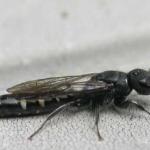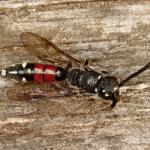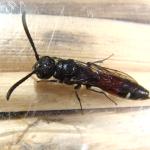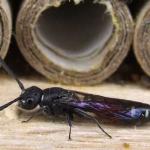Identification keys and general biology are given in Richards (1980), Gauld and Bolton (1988) and Yeo & Corbet (1995).
Cornwall to Kent, and north to Westmorland and North-east Yorkshire.
Overseas found in much of Europe (including Norway, Sweden, Denmark, The Netherlands, France, Germany, Italy, Austria, Hungary, Greece, Malta, Cyprus; the Middle East (Syria, Jordan, Israel, Turkey) and north Africa (Tunisia, Morocco).
This species is not regarded as being scarce or threatened.
Found in a wide variety of open habitats: woodland and shrubland, lowland heaths, chalk quarries, coastal cliffs, gardens and cemeteries. Often found flying around the nest sites of its hosts: mud, walls, holes in mortar, dead wood, old wooden posts, and snail shells.
Univoltine. Males are found during May and June, and rarely in July. Females occur mainly during June, often during May and July, or more rarely in April and August. In Cumbria, females may occasionally be found flying in mid-August (V. Russell 2016, pers. comm)
Thyme (Thymus sp, - Lamiaceae) is the only plant recorded in the BWARS Atlas, but it has since been seen foraging for nectar at flowers of Forget-me-not (Myosotis sp. - Boraginageae (J. Early 2016 pers. comm) and Fleabane (Pulicaria dysenterica - Asteraceae) in northern Cumbria (V. Russell 2016 pers.comm.).
SR - August 2016











